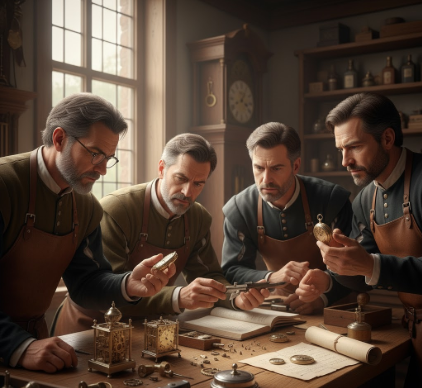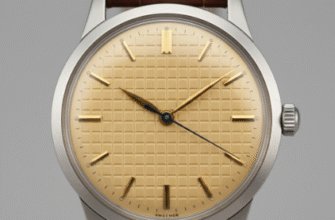In the burgeoning cities of 16th and 17th century Europe, the craft of watchmaking was a blend of high art, cutting-edge science, and jealously guarded secrets. A timepiece was not merely a tool; it was a symbol of wealth, status, and intellectual sophistication. In this chaotic and unregulated landscape, how could a wealthy patron be certain that the intricate, ticking marvel he was purchasing was the product of a true master and not a charlatan? The answer lay in the formidable power and unyielding standards of the watchmakers’ guilds.
These guilds were far more than simple trade unions. They were the gatekeepers of the profession, powerful organizations that controlled every facet of the watchmaking trade within a city’s walls. From London to Geneva, and Paris to Augsburg, guilds established a rigid framework designed to protect their members, regulate the market, and, most importantly, uphold a gold standard of quality that became synonymous with their city’s name.
The Crucible of Craftsmanship: The Apprenticeship System
The foundation of the guild’s quality control was its rigorous and lengthy training system. One could not simply decide to become a watchmaker. The path was long, arduous, and began in early youth. A boy, typically in his early teens, would be indentured to a master watchmaker as an apprentice for a period of five to ten years. This was not a casual arrangement; it was a legally binding contract that essentially made the apprentice a member of the master’s household.
Life as an apprentice was one of total immersion and relentless work. The early years were spent on menial tasks: sweeping the workshop, tending the forge, and polishing tools. Slowly, the apprentice would be introduced to the core skills, learning to file metal, draw wire, and finish components with meticulous precision. He would spend countless hours learning the esoteric properties of different metals, the complex mathematics of gear trains, and the delicate art of escapement assembly. Secrecy was paramount; the master’s unique techniques and innovations were to be guarded with one’s life.
From Journeyman to Master
Upon completing his apprenticeship, the young man became a
journeyman. The name itself, derived from the French word ‘journée’ for ‘day’, signified that he was now qualified to earn a daily wage. Many journeymen would travel for several years, a period known as the ‘Wanderjahre’ in German-speaking lands. This journey was a crucial part of their education, allowing them to work under different masters in various cities, absorbing new techniques and broadening their understanding of the craft. It was the horological equivalent of a postgraduate education.
The final, formidable hurdle was the creation of a
masterpiece. To be accepted into the guild as a full-fledged master with the right to open one’s own workshop, a journeyman had to present a piece of work to the guild’s elders for their scrutiny. This was no ordinary watch. It had to be a complex and flawlessly executed creation, often incorporating a complication like an alarm or a calendar function, demonstrating the maker’s absolute command over every aspect of the art. The masterpiece was the ultimate proof of skill, a testament to years of dedicated training. If it was accepted, the maker could pay his dues and be sworn in as a master, a respected member of the city’s elite craftsmen.
The regulations of the guilds were incredibly specific and legally enforceable. The Worshipful Company of Clockmakers of London, founded by Royal Charter in 1631, had the power to search for and seize any substandard watches or clocks within a ten-mile radius of the city. This authority allowed them to destroy poorly made items and fine the offending craftsmen, ensuring the reputation of London-made timepieces remained pristine.
Unyielding Standards and The Guild’s Mark
Beyond the strict training regimen, guilds enforced quality through a system of direct oversight and regulation. Guild officials, often elected masters, had the authority to inspect any workshop at any time. They would check the quality of raw materials, the precision of tools, and the finish of completed and in-progress pieces. Any work that did not meet the guild’s exacting standards could be confiscated and destroyed.
One of the most visible forms of this quality control was the use of
hallmarks and makers’ marks. When a watch was completed and passed inspection, it would be stamped with the guild’s official mark, a guarantee of its quality. Additionally, the master craftsman would stamp his own personal mark on the piece. This system created a clear chain of accountability. If a watch failed or was found to be fraudulent, the marks immediately identified the maker, who would face severe penalties, from hefty fines to expulsion from the guild—a move that would effectively end his career.
The Decline and Lasting Legacy
The iron grip of the guilds could not last forever. By the late 18th and early 19th centuries, new ideas about free trade and the burgeoning Industrial Revolution began to challenge the guild system’s very existence. The guilds were often seen as monopolistic and resistant to innovation, stifling the kind of rapid technological advancement that was beginning to take place. The rise of factory-based production, which prioritized volume over individual craftsmanship, was antithetical to the guild ethos.
Slowly, the legal powers of the guilds were dismantled, and their control over the trade waned. Yet, their legacy is indelible. The guilds cultivated a culture of excellence and an obsession with precision and durability that laid the groundwork for the modern luxury watch industry. The principles they championed—rigorous training, accountability, and an uncompromising commitment to quality—are the very same values that distinguish a high-end, handcrafted timepiece today. The spirit of the old masters, laboring for years to create a single, perfect masterpiece, lives on in the workshops of the world’s most prestigious watch brands. They are a direct echo of an era when quality was not just a goal, but the law.









